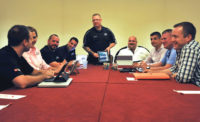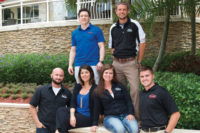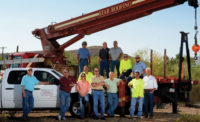
Less than 18 months ago, Roofing Contractor published a special "Cool Roofing" supplement that provided an excellent picture of the state of this technology as it applied to all types of roofing systems, including metal. The benefits of highly reflective cool roof coatings were already well established at that time, but since then there have been important advances, with a number of significant developments in 2005 alone. This year we saw research labs, utilities, government agencies and other interested groups focusing significant attention on cool metal roofing as they quantify and refine the energy-saving potential of these systems. Their findings could have a major impact on each of us-and on the metal roofing industry at large.
Title 24 and Metal Roofing
Clearly, much of the attention to cool roof technology in 2005 has been focused on the much-anticipated changes to Title 24, Part 6 of the California Code of Regulations. Title 24 establishes energy efficiency standards for California buildings, and is updated every three years. With the update that takes effect on Oct. 1 of this year, the law for the first time regulates energy efficiency for roofs in California.Without getting lost in the technical details of the "prescriptive," "performance" and "trade-off" approaches described by the regulations, here are some key points:
- Title 24's most immediate impact is on low-sloped non-residential roofs, where cool roofs are one of the required features under the standard "prescriptive" approach. For other types of buildings, cool roofs are an option for helping to meet the building's permitted energy budget.
- Title 24 defines a cool roof as a "roofing material with high solar reflectance and high emittance that reduces heat gain through the roof." To qualify as a cool roof, a product must be rated and certified according to the rating system developed by the Cool Roof Rating Council (CRRC).
- Title 24 applies to all new construction, as well as alterations or additions including reroofing projects. In terms of metal roofing, the most direct effects will be seen on non-residential buildings with low-sloped roofs (less than 2:12 pitch).
Regardless of the specific technical details, the impact of this year's Title 24 changes will be significant on the metal roofing industry. Not only is California a major market in its own right, it also is watched closely by other jurisdictions, which will undoubtedly study the effects of these new requirements on energy consumption and construction.

Who's Interested in Cool Metal Roofs?
As significant as Title 24 is, however, it is actually just one part of the cool roof story. Insofar as the metal roofing industry is concerned, Title 24's greatest immediate impact will be felt in one sector of the market-commercial buildings with low-slope roofs. But some of the greatest long-term potential for cool metal roofing systems may well be found in other applications (including residential uses) and in other locations throughout the country.
The truth of this became apparent to our company in March 2005, as we hosted the sixth and final scheduled meeting of the Cool Roof Colored Materials Project Advisory Committee. This committee was formed by the California Energy Commission to support the development of highly reflective energy-saving roof coatings. It was composed of researchers from leading national laboratories along with representatives of government agencies, utility companies and the building industry, as well as manufacturing partners such as our company.

Another sign of the ever-growing interest in cool roof technology came a few months later at the Eighth Annual Congressional Renewable Energy and Energy Efficiency Expo in Washington, D.C. This event attracted several dozen key figures in national energy policy including members of Congress, executive branch officials, congressional staff and journalists.
Here again we encountered a great deal of interest in the energy-saving potential of cool roof systems. Members of Congress and their staffers were particularly interested in learning what they could do to encourage the use of this energy-saving technology.
These are just a few examples, of course. The potential benefits of cool roof technology are drawing the interest of utilities, trade associations, industry groups and government agencies at all levels, not to mention the most powerful interest group of all: consumers. High-profile initiatives such as Energy Star® and the U.S. Green Building Council's Leadership in Energy and Environmental Design (LEED) rating system are producing more energy-conscious homeowners and home buyers. Not only are these consumers more likely to be interested in cool roof technologies, they also are better informed about the benefits.
Current Research Results
Thanks to continuing research, those consumer benefits of cool roof coatings are becoming more and more visible and quantifiable. For example, some of the research that was reported to the Cool Roof Colored Materials Project Advisory Committee last March involved results from a demonstration site in Fair Oaks, Calif., at which Lawrence Berkeley National Laboratory and Oak Ridge National Laboratory are monitoring the energy savings in two pairs of homes. Each pair of homes was identical in every way including floor plan, roof pitch and orientation to the sun. The only difference was that one home out of each pair was roofed with conventional painted metal shakes and the other was roofed with Custom-Bilt metal shakes with the ULTRA-Cool™ coating, a new highly reflective finish that was developed by BASF Corporation's Industrial Coatings Division.The study showed significant energy savings due to the ULTRA-Cool coating. For instance, during the month of September 2004, the amount of heat penetrating into the attic of the home with the ULTRA-Cool roof was 36 percent less than the home with the conventional coating. It is estimated this provided a nearly 20 percent saving in the energy required to cool the home.
Another case study involved two virtually identical 90,000-square-foot school buildings in neighboring school districts in Georgia. One school has a conventional green standing-seam metal roof with solar reflectance of 12 percent. The other has the same color metal roof but with solar reflectance of 29 percent. Compared to the conventionally roofed building, the cool-roofed school realized energy savings of about $8,800 for the first year of operation. These savings were measured and confirmed by the local electric utility, which attributed them solely to the cool roof technology.
Beyond immediate energy savings, these systems also hold the promise of even greater long-term durability-another obvious selling point with savvy consumers. Over 10,000 hours of accelerated exposure has proven these roofs are significantly more fade resistant than conventional roof coatings. Moreover, since a metal roof coated with a cool roof finish can be as much as 55 degrees cooler on a sunny day, the amount of heat expansion and contraction is also reduced, which will add to the roof's durability and longevity.
With the steady release of new research findings such as these, and with growing interest from consumers, regulators and industry groups, there is little doubt that the future of the metal roofing industry will be dramatically impacted by highly reflective cool roof finishes. The beneficiaries of these advances will include not just homeowners, utilities and manufacturers, but also those roofing contractors who have the foresight to position themselves to be part of this significant trend.



Report Abusive Comment